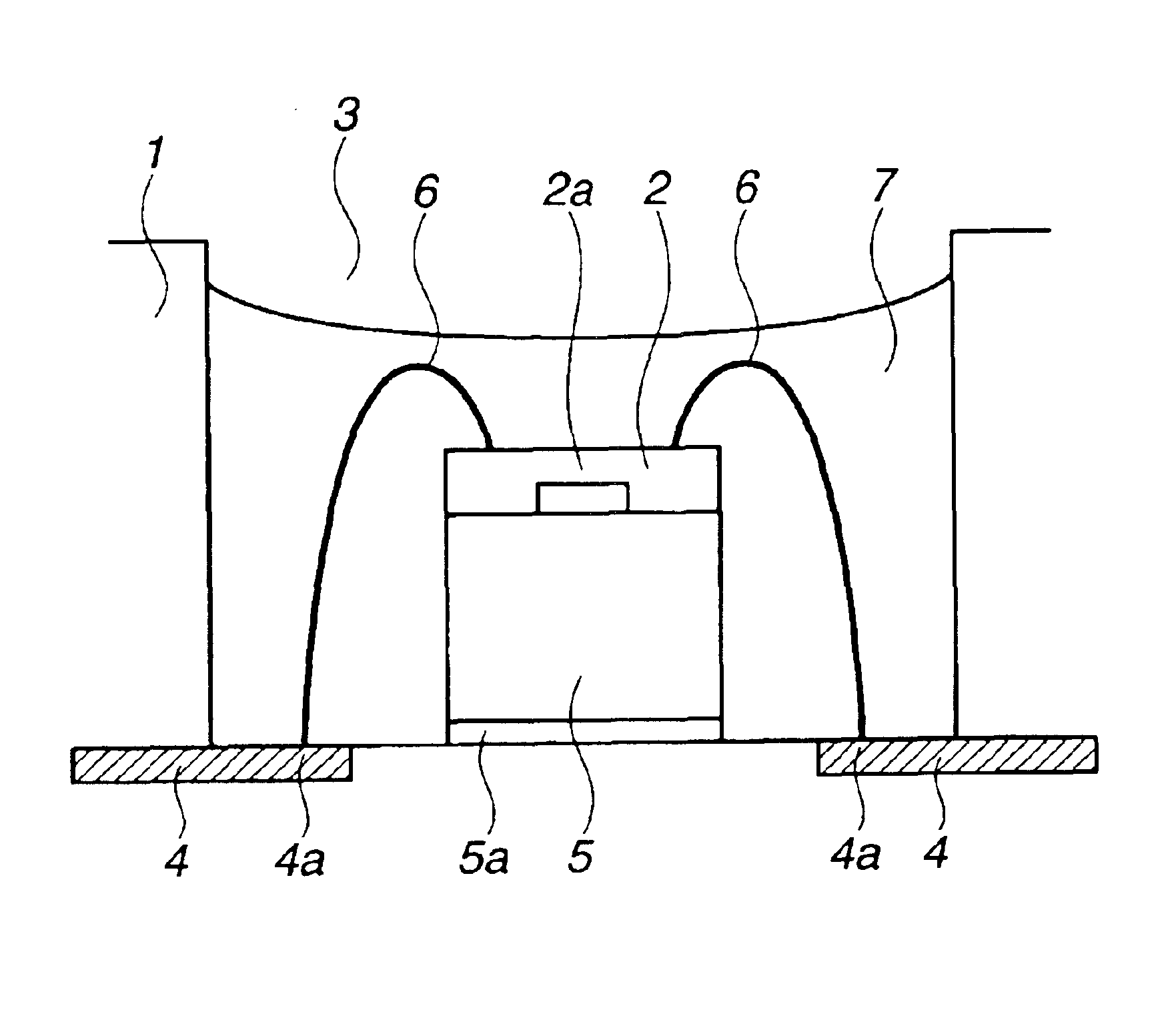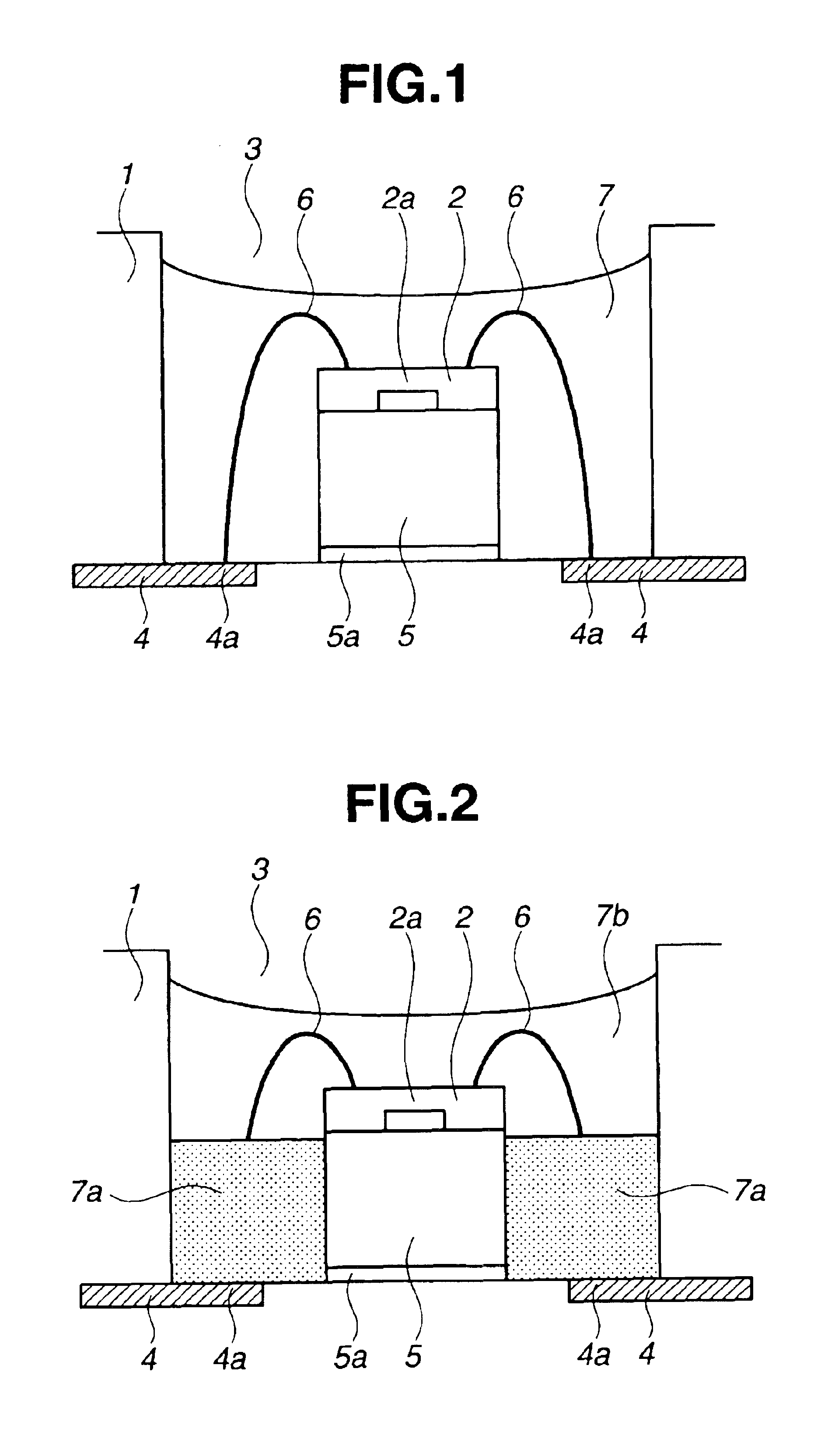Semiconductor pressure sensor device protected with perfluoropolyether gel
a technology of perfluoropolyether and pressure sensor, which is applied in the direction of fluid pressure measurement, instrumentation, and device details of the semiconductor/solid-state device, can solve the problems of gel material cracking, insulating/protecting function, and sensor function itself being lost, so as to improve the adhesive strength of the rubber material to any mating material, and reduce the tg of the rubber material
- Summary
- Abstract
- Description
- Claims
- Application Information
AI Technical Summary
Benefits of technology
Problems solved by technology
Method used
Image
Examples
first embodiment
Referring to FIG. 1, there is illustrated in elevational cross-section a semiconductor pressure sensor device according to the first embodiment of the invention. A resinous housing 1 is made of a filled resin such as an epoxy resin, polyphenylene sulfide (PPS) or polybutylene terephthalate (PBT) and defines a cavity 3 where a semiconductor sensor chip 2 is to be mounted.
The resinous housing 1 has been molded over a plurality of insert pins 4 (also referred to as “leads,” herein) made of an electrically conductive material such as copper by an insert molding technique so that the insert pins 4 are embedded in the housing 1. Of the plurality of insert pins 4, four insert pins are located at the four corners of the cavity 3 at the bottom and exposed thereat within the cavity 3. The exposed portions of the insert pins 4 are plated with gold and serve as bonding pads 4a.
The semiconductor sensor chip 2 used herein is a sensor chip of well-known construction utilizing a piezoresistance ef...
second embodiment
While the first embodiment described above relies on the protective material consisting of a single fluorochemical gel material, the second embodiment differs therefrom in that the protective material consists of two species of material having different modulus of elasticity due to different crosslinking density.
Referring to FIG. 2, there is illustrated in elevational cross-section a semiconductor pressure sensor device according to the second embodiment of the invention. Since the second embodiment contains the same elements in substantially the same configuration as in the first embodiment except for the above difference, like parts in FIGS. 1 and 2 are designated by the same numerals for the sake of brevity of description.
In the device of the second embodiment, the protective material 7 filled in the cavity 3 for covering the sensor chip 2 and bonding wires 6 has a two-layer structure consisting of a first protective material 7a on the lower layer side (cavity bottom side) and a ...
preparation example 1
In 100 parts of a polymer having formula A-1 (viscosity 2,100 cSt) and 33 parts of a polymer having formula E-1, 1.5 parts of Aerosil R-976 (Nippon Aerosil Co., Ltd.) was compounded. This was combined with 0.3 part of a 50% toluene solution of ethynyl cyclohexanol, 0.2 part of a toluene solution containing a vinylsiloxane complex of chloroplatinic acid (platinum metal concentration 0.5 wt %), 6.2 parts of a compound having formula C-1, 1.5 parts of a compound having formula C-2, and 1.5 parts of a compound having formula G-1. These components were uniformly mixed to form a rubber composition 1.
The composition was press molded at 150° C. for 10 minutes and post-cured at 150° C. for 50 minutes, yielding a rubber material 1. The physical properties (hardness, tensile strength and elongation) of the cured part were measured according to JIS K6249. The degree of saturation swelling in gasoline (using unleaded gasoline) was measured according to JIS K6258 under immersion conditions: 23° C...
PUM
| Property | Measurement | Unit |
|---|---|---|
| glass transition temperature | aaaaa | aaaaa |
| glass transition temperature | aaaaa | aaaaa |
| temperature | aaaaa | aaaaa |
Abstract
Description
Claims
Application Information
 Login to View More
Login to View More - R&D
- Intellectual Property
- Life Sciences
- Materials
- Tech Scout
- Unparalleled Data Quality
- Higher Quality Content
- 60% Fewer Hallucinations
Browse by: Latest US Patents, China's latest patents, Technical Efficacy Thesaurus, Application Domain, Technology Topic, Popular Technical Reports.
© 2025 PatSnap. All rights reserved.Legal|Privacy policy|Modern Slavery Act Transparency Statement|Sitemap|About US| Contact US: help@patsnap.com



